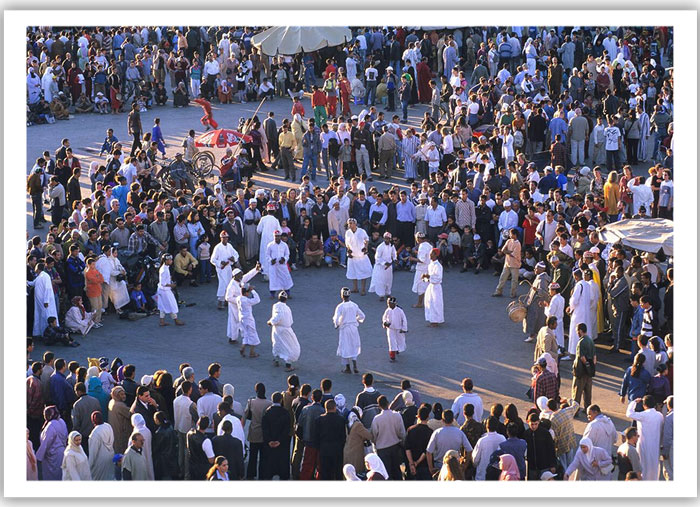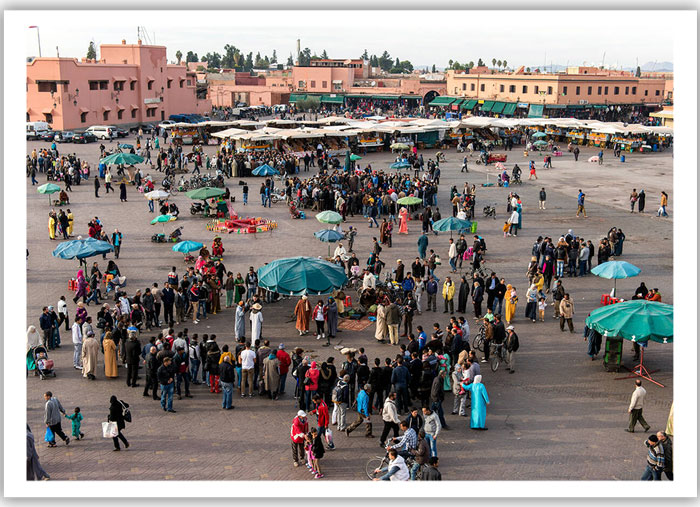Storytelling in Morocco: The Ancient Art of “Halqa”
Imagine walking through the bustling medina of Marrakech or Fes, where narrow streets are alive with the aroma of spices, merchants calling out their wares, and the rhythmic beat of a gimbri. In a quiet square, a crowd gathers in a circle, eyes fixed on the storyteller at the center. This is the timeless tradition of Halqa storytelling in Morocco.
Halqa—literally meaning “circle” in Arabic—is Morocco’s ancient art of oral storytelling. For centuries, Moroccans have gathered in public squares to listen to tales blending history, myth, humor, and moral lessons. These performances were traditionally passed down orally, serving as both entertainment and a way to preserve Morocco’s rich cultural heritage.
In today’s digital age, Halqa storytelling in Morocco continues to captivate audiences, offering a rare glimpse into the country’s social values, humor, and imagination. In this article, we’ll explore the origins, techniques, and modern relevance of Halqa, revealing why this centuries-old tradition remains a cornerstone of Moroccan culture.
Origins of Halqa
The roots of Halqa storytelling in Morocco stretch back centuries, tracing a rich tapestry of cultural influences. This tradition is deeply embedded in Moroccan society, reflecting the country’s diverse history and vibrant oral culture.
Historical Roots
Halqa originates from a blend of Berber, Arab, and Andalusian influences. Before the widespread use of written texts, oral storytelling was the primary means of preserving history, legends, and moral teachings. Traveling storytellers, often called “Hkayas”, would perform in town squares, markets, and festivals, bringing communities together through shared narratives.

Cultural Significance
Storytelling in the Halqa tradition served multiple purposes:
-
Entertainment: In the absence of modern media, Halqa provided hours of amusement.
-
Education: Tales conveyed lessons about bravery, honesty, and social values.
-
Preservation of History: Many stories preserved historical events, dynasties, and cultural heroes long before they were documented in writing.
Influences
-
Berber Traditions: Early Moroccan tales were influenced by local Berber myths, featuring spirits, heroes, and nature-inspired narratives.
-
Arab Influence: With the Arab conquest of North Africa, storytelling absorbed elements of Arabic poetry, proverbs, and Islamic morals.
-
Andalusian Influence: After the fall of Granada, Andalusian refugees brought poetic and musical storytelling styles that enriched the Halqa tradition.
Through these diverse influences, Halqa storytelling in Morocco became more than just tales—it evolved into a performative art, combining speech, music, gestures, and audience interaction.
The Structure of a Halqa
A Halqa performance is much more than a storyteller speaking—it’s a dynamic, interactive experience that combines oral storytelling, music, and audience participation. Understanding its structure helps appreciate why Halqa storytelling in Morocco has endured for centuries.
1. The Setting
-
Typically held in public squares, such as medinas, souks, or festival grounds.
-
The term “Halqa” itself means “circle”, describing how the audience gathers around the storyteller.
-
The setting is often informal, allowing passersby to join spontaneously.
2. Circle Formation
-
The storyteller stands in the center of the circle, commanding attention with gestures and voice modulation.
-
Audience members sit or stand around, creating an intimate and immersive atmosphere.
-
Interaction is key: laughter, applause, or shouts from the crowd often guide the flow of the story.
3. Performance Elements
-
Voice Modulation: Storytellers change pitch, tone, and speed to convey emotions.
-
Gestures and Movement: Hands, facial expressions, and body movements enhance dramatic moments.
-
Music and Sound: Instruments like the gimbri or small percussion may accompany certain stories.
-
Improvisation: Storytellers often adapt tales depending on the audience, time, or occasion.
4. Common Themes
-
Moral Lessons: Tales emphasize virtues like honesty, bravery, and kindness.
-
Historical Events: Stories about dynasties, battles, and legendary figures.
-
Folklore and Myth: Spirits, djinns, magical creatures, and enchanted lands.
-
Humor and Satire: Comic episodes reflecting social norms, daily life, and human folly.
5. Audience Participation
-
Storytelling in Halqa is not one-way; the crowd reacts vocally or through gestures.
-
Children often sit closest, absorbing lessons and developing an early appreciation for oral tradition.
-
Adults may interject comments or ask questions, creating a lively, communal experience.
Famous Moroccan Storytellers
The art of Halqa storytelling in Morocco owes much of its charm and longevity to the skill and charisma of its storytellers. These performers have played a vital role in preserving Moroccan oral traditions while engaging generations of audiences.
1. Historical Storytellers
-
Many Halqa performers gained legendary status in Moroccan history for their eloquence and creativity.
-
Traditional storytellers, often known as “Hkayas” or “qissas” narrators, passed down tales of Moroccan heroes, folktales, and moral lessons.
-
These storytellers were highly respected within communities, sometimes considered as guardians of cultural memory.
2. Contemporary Masters
-
While urbanization and modern entertainment have reduced their numbers, several contemporary storytellers continue the tradition.
-
Cities like Marrakech, Fes, and Meknes still host Halqa performances, particularly in squares like Jemaa el-Fnaa, where skilled narrators captivate tourists and locals alike.
-
Modern storytellers may blend traditional tales with contemporary themes, addressing social issues or modern humor while retaining the essence of Halqa.
3. Notable Performances and Anecdotes
-
Famous Halqa storytellers often become local celebrities, attracting crowds that sometimes number in the hundreds.
-
Anecdotes recount performers improvising entire tales based on audience suggestions, showcasing their wit and memory.
-
Some storytellers specialize in poetic forms, incorporating traditional Moroccan rhymes and music to enhance their narratives.
4. Role in Preserving Moroccan Culture
-
Storytellers act as living archives, keeping legends, history, and moral lessons alive.
-
By performing regularly, they ensure that younger generations experience Morocco’s oral heritage firsthand.
-
Even in tourist-heavy areas, authentic Halqa storytellers maintain cultural integrity, resisting the dilution of their art.
Halqa in Moroccan Society
Halqa storytelling in Morocco is far more than a form of entertainment—it has historically played a central role in shaping community life, educating audiences, and preserving cultural identity.
1. Social Role
-
Halqa performances create a sense of community, bringing people together from all walks of life.
-
Town squares where Halqa takes place serve as hubs of social interaction, where news, gossip, and cultural knowledge are shared.
-
The circular seating arrangement encourages inclusivity, allowing everyone—children, elders, and visitors—to participate.
2. Education and Moral Lessons
-
Many Halqa stories are didactic, teaching children virtues such as honesty, courage, kindness, and respect.
-
Adults also gain insights through satire, allegories, and historical narratives, reinforcing societal norms and values.
-
In a largely oral society of the past, Halqa was an essential vehicle for informal education.
3. Festivals and Special Occasions
-
Halqa performances are integral to Moroccan festivals, weddings, and religious celebrations.
-
Certain towns host annual storytelling gatherings, celebrating the art and encouraging new generations to participate.
-
These events often feature music, dance, and poetry alongside storytelling, creating a rich cultural tapestry.
4. Audience Interaction
-
A defining feature of Halqa is its dynamic interaction between storyteller and audience.
-
Crowds respond with laughter, applause, or vocal reactions, influencing the flow of the story.
-
Children often imitate actions and repeat lines, ensuring the continuity of oral traditions.
5. Preservation of Cultural Identity
-
Halqa reinforces Morocco’s unique cultural heritage, blending Arab, Berber, and Andalusian influences.
-
By attending performances, communities maintain a living connection to their history, myths, and traditional values.
-
The tradition also promotes intergenerational learning, passing down knowledge and cultural pride.
Experience Halqa Storytelling in Morocco!
Don’t miss the chance to witness this timeless Moroccan tradition in person. Plan your visit to Marrakech, Fes, or Meknes, and step into the vibrant world of Halqa storytelling. Explore local squares like Jemaa el-Fnaa, attend cultural festivals to see special performances, and support local storytellers by tipping or purchasing crafts.
Plan Your Halqa Experience Today
Modern Evolution
While Halqa storytelling in Morocco is an ancient tradition, it has not remained static. Over time, it has evolved to adapt to modern society, ensuring that this cultural treasure continues to thrive.
1. Adaptation to Contemporary Themes
-
Modern storytellers often incorporate current social issues, humor, and urban life into traditional narratives.
-
Some performances address topics like migration, education, and environmental challenges, making Halqa relevant to today’s audiences.
-
Despite these updates, the core storytelling techniques—oral narration, gestures, and audience engagement—remain unchanged.
2. Halqa in Tourism and Media
-
Cities like Marrakech, Fes, and Essaouira showcase Halqa as part of cultural tourism, particularly in famous squares such as Jemaa el-Fnaa.
-
Halqa is now featured in documentaries, cultural programs, and online platforms, exposing global audiences to Morocco’s oral heritage.
-
These efforts help support local storytellers financially while preserving authenticity.
3. Challenges in Modern Times
-
Urbanization, digital entertainment, and changing lifestyles have reduced regular audiences in traditional squares.
-
Some purists worry that commercialization could dilute the art form, prioritizing spectacle over substance.
-
Efforts are being made by cultural organizations and festivals to maintain authentic Halqa performances, keeping traditional storytelling alive.
4. Cultural Revitalization
-
Educational programs and storytelling workshops are introducing Halqa to younger generations.
-
Universities and cultural institutions study the art form, documenting its history and techniques.
-
This combination of preservation and innovation ensures that Halqa storytelling in Morocco remains a living, evolving tradition.
Experiencing Halqa Today
For travelers and locals alike, witnessing Halqa storytelling in Morocco is a truly immersive cultural experience. The tradition continues to thrive in select locations where audiences can enjoy authentic performances.
1. Best Cities and Locations
-
Marrakech: The most famous spot is Jemaa el-Fnaa, a UNESCO-recognized square where storytellers perform daily.
-
Fes: Halqa can be found in medina squares, especially during festivals or cultural events.
-
Meknes & Essaouira: Smaller towns also host Halqa circles, often during local celebrations or artisan markets.

2. Timing Your Visit
-
Performances usually take place late afternoon to evening, when the crowds gather and the atmosphere is lively.
-
Festivals such as Moussem of Tan-Tan or local cultural weeks often include special Halqa storytelling events.
-
Planning around these times ensures a more engaging and vibrant experience.
3. Etiquette and Tips
-
Respect the circle: Sit quietly and avoid interrupting unless invited to participate.
-
Observe customs: Photography may be restricted or require permission.
-
Engage respectfully: Applaud, laugh, or respond when the storyteller encourages audience interaction.
-
Support local storytellers: Consider tipping or purchasing related crafts, supporting the sustainability of the art.
4. Why Experience Halqa
-
It offers a window into Moroccan culture, blending history, folklore, and moral lessons.
-
Provides a social experience, connecting visitors with locals in a shared moment of cultural appreciation.
-
Experiencing Halqa in person allows audiences to witness the energy, improvisation, and skill of storytellers—something no video or book can replicate.
Conclusion
Halqa storytelling in Morocco is far more than a centuries-old tradition—it is a living art form that continues to captivate audiences, preserve cultural heritage, and foster community connections. From the bustling squares of Marrakech and Fes to smaller towns where storytellers still gather crowds, Halqa remains a vibrant part of Moroccan society.
Through its unique combination of oral narration, gestures, music, and audience interaction, Halqa not only entertains but also educates, passing down moral lessons, historical narratives, and folklore to each new generation. While modern challenges like urbanization and digital entertainment have impacted its traditional spaces, Halqa has evolved, embracing contemporary themes, festivals, and even media exposure to remain relevant in today’s Morocco.
For travelers and culture enthusiasts, experiencing a Halqa performance is a chance to witness the heart of Moroccan storytelling, connect with local communities, and appreciate the richness of an oral tradition that has survived for centuries. By attending and supporting these performances, audiences play a part in ensuring that Halqa storytelling in Morocco continues to thrive for generations to come.
